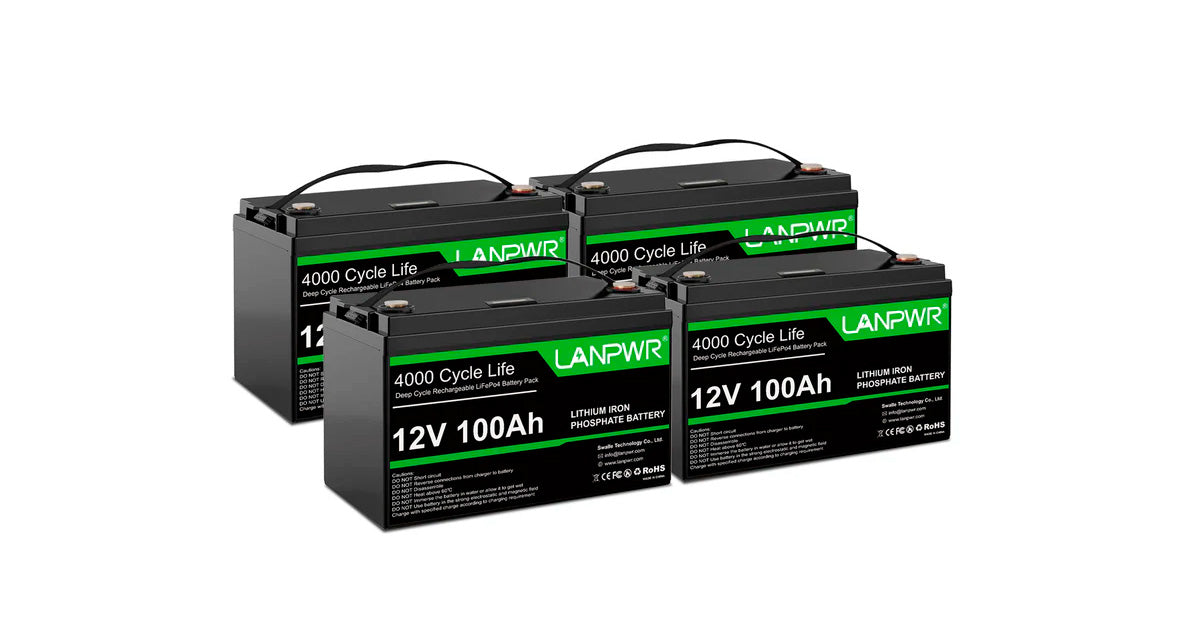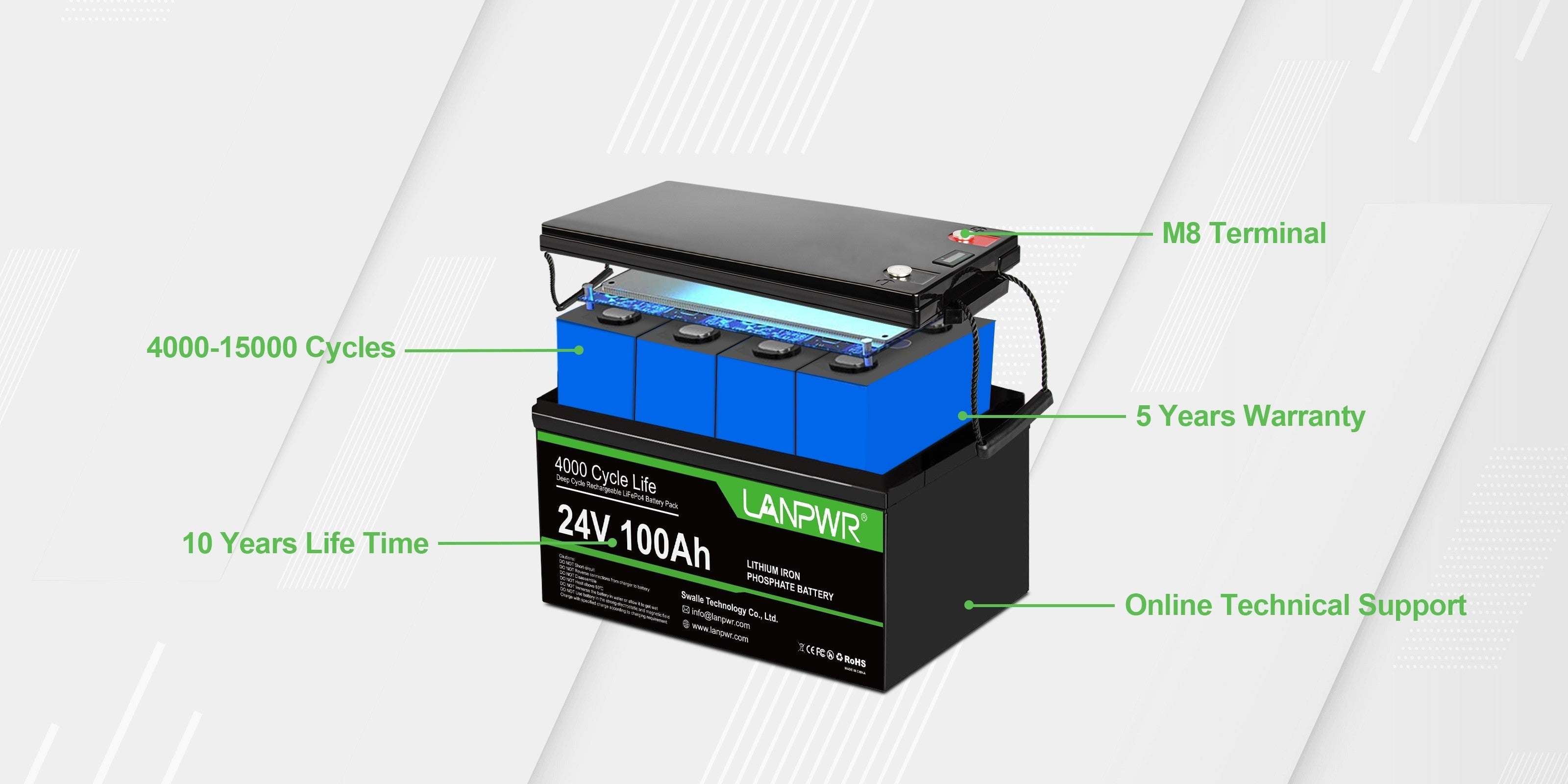In this comprehensive exploration of battery technology, we delve into the significant strides made from the past to the present. As battery technologies have evolved, their roles in powering everything from small gadgets to large vehicles have become increasingly pivotal. LANPWR, renowned for its leadership in battery performance, stresses the importance of understanding battery cycle life and its direct impact on longevity. This knowledge not only helps in choosing the correct battery but also in optimizing its usage for extended life.
Understanding Battery Basics
Types of Batteries
The battery technology landscape includes various types, each tailored for specific needs and applications. Lithium-ion (Li-ion) batteries are particularly prevalent due to their superior charge and discharge efficiency, which preserves battery health over many cycles. In contrast, while older in technology, lead acid batteries are valued for their durability and cost-effectiveness, making them suitable for bulk energy storage and automotive uses.
What are Battery Cycles?
A battery cycle refers to charging a battery to full capacity and then discharging it completely. A battery's longevity is measured in these cycles, with the cycle life indicating how many complete charge and discharge cycles a battery can handle before its capacity falls to a certain level of its original capacity. Lithium-ion batteries, for instance, can sustain many more cycles than other battery types, offering greater reliability and efficiency for long-term use.
Factors Influencing Battery Longevity
Depth of Discharge (DoD)
The Depth of Discharge (DoD) is a crucial factor affecting a battery's lifespan. Batteries fully discharged to 100% DoD tend to wear out faster than those that undergo only partial discharges. This excessive use can rapidly degrade the battery’s chemical components, reducing its overall life expectancy. By limiting the DoD to less severe levels, such as 50% or less, the stress on the battery is minimized, which can significantly extend the number of possible discharge cycles and, consequently, the effective lifespan of the battery. Implementing a strategic charging routine that avoids full depletion can help maintain the battery's structural integrity over time.
Charging Practices
The method and manner of battery charging are integral to maximizing battery life. Fast charging provides the convenience of speed but at the cost of accelerated battery wear. While fast charging technologies are designed to deliver quick power boosts, they also generate higher heat and stress the battery more than slower charging methods. Maintaining a battery’s charge between 20% and 80% rather than charging to full capacity (100% charge) can help prolong the battery's health and operational life. It is advisable to use a charger that matches the manufacturer's specifications and to avoid leaving the battery plugged in once it has reached its optimal charge level, as this can prevent overcharging and extend battery health.
Temperature and Environmental Conditions
Temperature plays a vital role in battery management. Both excessive heat and severe cold can impair battery performance and precipitate its decline. High temperatures can cause the battery fluids to evaporate, leading to internal damage and reduced capacity. Conversely, cold temperatures can thicken the internal fluids, slowing down the chemical reactions necessary for power generation. The longevity of battery packs can be preserved by adhering to optimal storage and operational practices, such as keeping the battery in a controlled environment and avoiding exposure to extreme temperature conditions. Regular checks and balances in maintaining the environmental conditions where batteries are stored and used can significantly influence their performance and lifespan.

Maintaining and Prolonging Battery Life
Regular Maintenance
Regular maintenance is pivotal to ensuring the sustained performance and longevity of batteries. This encompasses:
- Periodic Checks: Regularly scheduled inspections are crucial to verifying the health and functionality of each cell within the battery pack. This helps identify and rectify any potential issues before they escalate.
- Balancing Battery Packs: To ensure optimal performance and longevity, the battery pack must be balanced. This involves adjusting the charge levels of individual cells to match each other, which prevents any single cell from underperforming or overcharging.
- Connection Inspections: Maintaining the integrity of all electrical connections is key to preventing power loss and potential safety hazards. It is important to clean and inspect these connections regularly to ensure they are free of dirt, corrosion, or any obstruction that might impede the battery’s efficiency.
Technological Aids
Integrating advanced technological aids significantly enhances the lifespan of batteries, particularly those in high-demand applications. These include:
- Smart Charging Systems: These systems are designed to optimize charging cycles based on the battery's usage patterns and condition. By preventing overcharging and promoting efficient energy management, they help extend the battery's life.
- Battery Management Systems (BMS): A BMS is critical for maintaining the battery's health over its lifetime. It continuously monitors the battery's state, such as its voltage, temperature, and charge levels, and adjusts the parameters to ensure optimal conditions. This prolongs the battery’s life and enhances its performance and safety.
Comparative Analysis of Battery Performance
Lithium-ion vs. Lead Acid
Lithium-ion batteries outperform lead-acid batteries in performance and endurance. They offer better cycle life, efficiency, and reliability, making them the preferred choice for applications that require robust and long-lasting power sources. Lithium-ion batteries also benefit from a higher energy density, allowing them to store more electrical energy per unit of weight than their lead-acid counterparts. This feature is particularly advantageous in portable devices and electric vehicles, where reducing weight is crucial to enhancing performance.
The superiority of lithium-ion batteries extends to their environmental impact and maintenance requirements. Unlike lead-acid batteries, which often contain hazardous materials and require regular water top-ups, lithium-ion batteries are typically maintenance-free and have a lower environmental footprint when disposed of properly. Additionally, they do not experience the memory effect that can reduce the usable capacity of some rechargeable batteries, thus providing more reliable and consistent power over time.
How Batteries Perform Under Different Conditions
Performance analysis through case studies and expert opinions consistently shows that batteries maintained under ideal conditions—avoiding full discharges and extreme temperatures—last longer and perform better. These findings underscore the importance of understanding the operational environment and adhering to manufacturer guidelines for charging and storage. Batteries exposed to high temperatures or allowed to discharge completely regularly often suffer from reduced longevity and degraded performance, which can significantly impact the overall efficiency of the device they power.
Furthermore, batteries' performance can also be influenced by how they are charged. A charging protocol matching the battery's specifications can greatly enhance its lifespan and function. For instance, fast charging can be beneficial in terms of reducing downtime, but it must be implemented carefully to avoid excessive heat build-up, which can adversely affect battery health. Consequently, choosing the right charger and observing optimal charging practices are pivotal in maximizing a battery’s lifespan and maintaining its performance across various conditions.
Future Trends in Battery Technology
Innovations Prolonging Battery Life
The advancements in lithium-ion technology are enhancing battery capacities and lifespans, improving their safety profiles, and reducing environmental impacts. These innovations are crucial as the demand for high-performance, long-lasting batteries grows. New developments in electrode materials and electrolyte formulations lead to batteries that can operate more efficiently under a broader range of temperatures and charging conditions. This extends the battery life and enhances their performance, making them safer and more reliable across various applications, from mobile devices to electric vehicles.
In addition to material improvements, there is significant progress in integrating smart technology within battery systems. Smart batteries equipped with sensors and advanced management systems can actively monitor their health, predict failures, and optimize power usage based on the device's needs. This technology helps prevent overcharging and deep discharging, which can severely degrade battery life. By tailoring the battery's behavior to its usage patterns, these smart systems ensure that batteries maintain their capacity for longer periods, thereby supporting the push towards more durable and dependable energy solutions.

Sustainable Practices in Battery Usage
Sustainability is increasingly becoming a focal point in battery technology. Efforts to make battery usage more sustainable, such as improving recycling processes and enhancing the reusability of battery components, are pivotal in reducing the overall environmental footprint of battery technologies. Innovations such as developing eco-friendly battery materials that are less toxic and easier to recycle contribute significantly to this end. Researchers and manufacturers are focusing on designing batteries that can be easily dismantled and have materials recovered at the end of their life, which can then be reused to create new batteries.
Furthermore, regulatory frameworks and economic incentives are being developed to support adopting sustainable practices within the industry. These policies encourage manufacturers to adopt cleaner production techniques and offer consumers benefits when choosing greener options. For example, some governments are providing subsidies for battery recycling facilities and tax incentives for companies that use recycled materials in their battery production. Such measures promote a circular economy in battery manufacturing and encourage ongoing research into more sustainable battery technologies, aiming to meet environmental standards without compromising performance.
A thorough understanding and appropriate management of batteries can significantly prolong their life. With ongoing advancements and a commitment to sustainable practices, the future of battery technology looks both promising and exciting. As we continue to innovate and improve upon current battery technologies, there is a clear path toward more efficient and environmentally friendly solutions. Trust in LANPWR to deliver dependable, cutting-edge battery solutions that meet the demands of today and pave the way for a sustainable tomorrow. By investing in research and development, LANPWR is at the forefront of creating battery systems that exceed performance expectations and adhere to stringent sustainability criteria. This ensures that as we progress, we do so with a responsible outlook toward our planet's resources, aiming for a balance between technological advancement and environmental stewardship.













Leave a comment
This site is protected by hCaptcha and the hCaptcha Privacy Policy and Terms of Service apply.